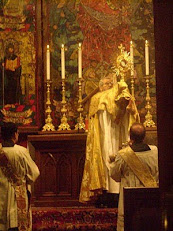March 3, 2010
by Matthew Alderman
There has been a lot of water under the bridge (equal parts Tiber and Thames, to be exact) in the last month on the subject of the projected Anglican Ordinariates. Our friends over at The Anglo-Catholic have kept up such a massive volume of informative and interesting postings since their inception that it has become difficult for me to keep up with them, but, at the least, the headline item in this post is quite up-to-date and extremely exciting. The Anglican Church in America, the American branch of the Traditional Anglican Communion (TAC), has formally requested that the Holy See implement the provisions of Anglicanorum cœtibus. Christian Campbell has more here.
***
What will the new Ordinariate's liturgy or liturgies look like? There has been an enormous amount of speculation on the subject of what Ordinariate liturgies might look like, ranging from pure Sarum to the Book of Divine Worship and back again...
Read the rest at the blog of The New Liturgical Movement.
Obituary of a very failed Pontificate
-
"Nun khre methusthen kai tina per bian ponen, epei de katthane
Mursilos."Such would have been the reaction of the unchristianised Greeks.
But for us, for t...
6 months ago














No comments:
Post a Comment